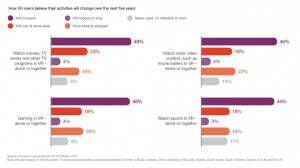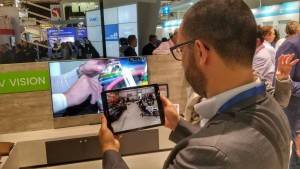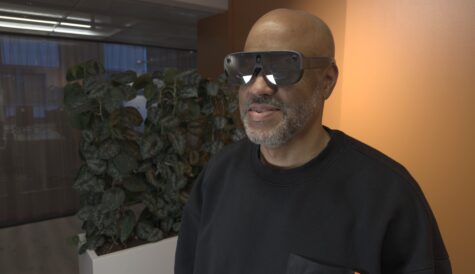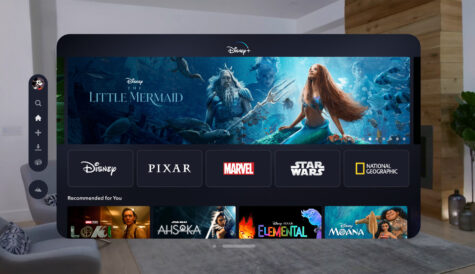
After more than 40 years of operation, DTVE is closing its doors and our website will no longer be updated daily. Thank you for all of your support.
ConsumerLab 2017: Making the Social VR Experience a Reality
Olie Baumann, senior technical specialist, video processing, Ericsson Media Solutions, looks at the importance of social media to VR.
 The consumption of media has always been a sociable experience.
The consumption of media has always been a sociable experience.
From live global events such as the first man on the moon or the fall of the Berlin Wall to sports events like the Olympics or local football matches, we often watch together. Anytime, anywhere, on-demand viewing now increasingly takes place on personal mobile devices making watching TV a more individual, fundamentally less sociable activity. At first glance, the head mounted devices used for virtual reality (VR) take this personal isolation a step further. I would argue, however, that this emerging way of consuming media may, in fact, offer TV providers a way of creating new social TV experiences in the future.
VR is gaining ground
 Although it’s still early days, VR is starting to gain consumer acceptance. What started as the reserve of the dedicated computer gamer is now spreading to other forms of entertainment. Driven in part by the ubiquity of tablet and mobile phone devices with integrated sensors and sufficient processing power to deliver a high quality immersive experience, VR is starting to reach the mass market. The latest Ericsson ConsumerLab TV and Media report, which gathered quantitative data from 20,000 online interviews from people in 13 markets, found that around 10 percent of consumers are already using a VR device, and over 25 percent are planning to get one. Furthermore, 30 percent of consumers are intending to use VR for video content within the next five years.
Although it’s still early days, VR is starting to gain consumer acceptance. What started as the reserve of the dedicated computer gamer is now spreading to other forms of entertainment. Driven in part by the ubiquity of tablet and mobile phone devices with integrated sensors and sufficient processing power to deliver a high quality immersive experience, VR is starting to reach the mass market. The latest Ericsson ConsumerLab TV and Media report, which gathered quantitative data from 20,000 online interviews from people in 13 markets, found that around 10 percent of consumers are already using a VR device, and over 25 percent are planning to get one. Furthermore, 30 percent of consumers are intending to use VR for video content within the next five years.
Overcoming the reality of technological barriers
 Although we often associate VR with strange looking goggles, the use cases are in fact much more varied. For example, 360º video that allows the user to orientate their view within the scene could be displayed on a large living room TV or tablet. Furthermore, a tablet or mobile phone could be used as a second screen showing 360º content in synchronization with the TV broadcast. Imagine sitting with friends watching sports with the live broadcast on the TV as it is today but with additional, synchronised 360º content on phones and tablets. Discussions around the best angle to view a goal or the best driver to ride along with can only add to the sociability of the experience.
Although we often associate VR with strange looking goggles, the use cases are in fact much more varied. For example, 360º video that allows the user to orientate their view within the scene could be displayed on a large living room TV or tablet. Furthermore, a tablet or mobile phone could be used as a second screen showing 360º content in synchronization with the TV broadcast. Imagine sitting with friends watching sports with the live broadcast on the TV as it is today but with additional, synchronised 360º content on phones and tablets. Discussions around the best angle to view a goal or the best driver to ride along with can only add to the sociability of the experience.
At IBC 2017, Ericsson worked with Sky and 360º video specialist Tiledmedia to create demonstrations showing how VR and 360 videos can be synchronized with Premier League soccer and Formula 3 motor racing content using VR headsets, tablets and traditional TV screens. The demo uses Viewport-Adaptive streaming technology along with Ericsson’s HEVC software encoding technology to dramatically reduce bandwidth consumption and optimize the video quality for each device.
The demonstration highlighted the work taking place to overcome one of the biggest challenges of 360º video; creating platforms that allow content producers to capitalize on the untapped potential without having to dramatically increase production complexity and costs.
A unified approach to making VR a reality
The production of 360º content is still at an early stage but already seems to have captured the minds of creative storytellers. The format poses production challenges, but overcoming these give an opportunity for innovation. Placing the 360º camera on top of the broadcast camera for a live sports even, for example, gives the consumer the opportunity to see not only the view captured for broadcast, but also, how it was captured, complete with crew and microphone boom! The heightened impact an immersive 360º experience has on the consumer will, no doubt, be of great interest to advertisers. This in turn will feed into the monetization models which will be necessary for the success of the format.
The technology for the capture, storage and delivery of 360º video has made a great deal of progress in recent months. Ericsson has become part of the recently formed Virtual Reality Industry Forum (VRIF) advocating for consensus around industry standards for the creation of an interoperable, end-to-end ecosystem for high-quality audio-visual VR services. As an ongoing process, the industry is progressing Omnidirectional Media Application Format (OMAF), as part of an end-to-end ecosystem for managing the creation, integration and distribution of VR and 360 content.
Where next for VR?
The Ericsson ConsumerLab report shows us there is an appetite for more immersive experiences through VR in the future. To meet consumer demand for this and monetize the offering effectively, technology players need to find common standards and scalable solutions that address some of the challenges around delivering a high-quality VR experience. In solving these, it’s possible for VR to become a format that is able to bring a new social viewing experience.


